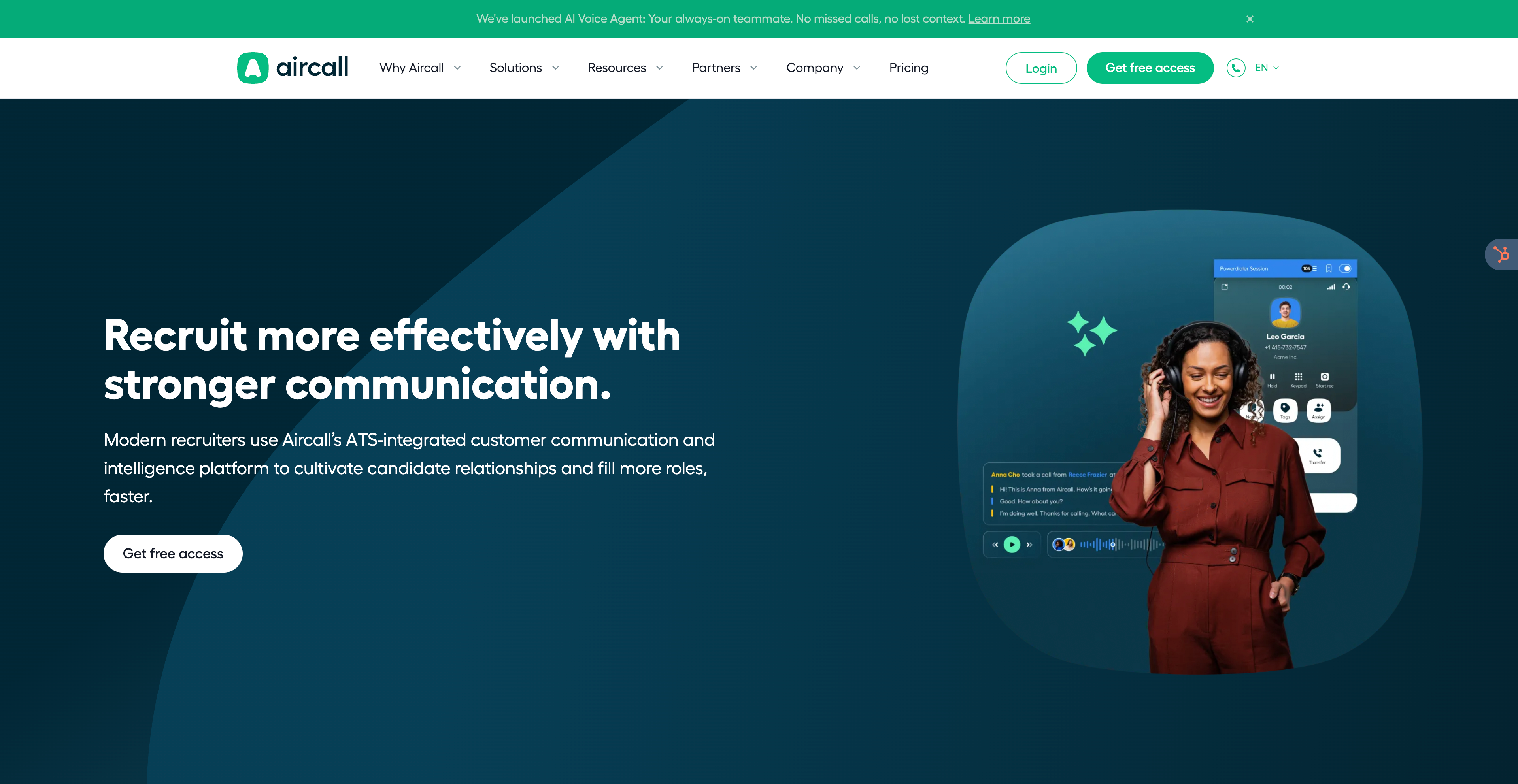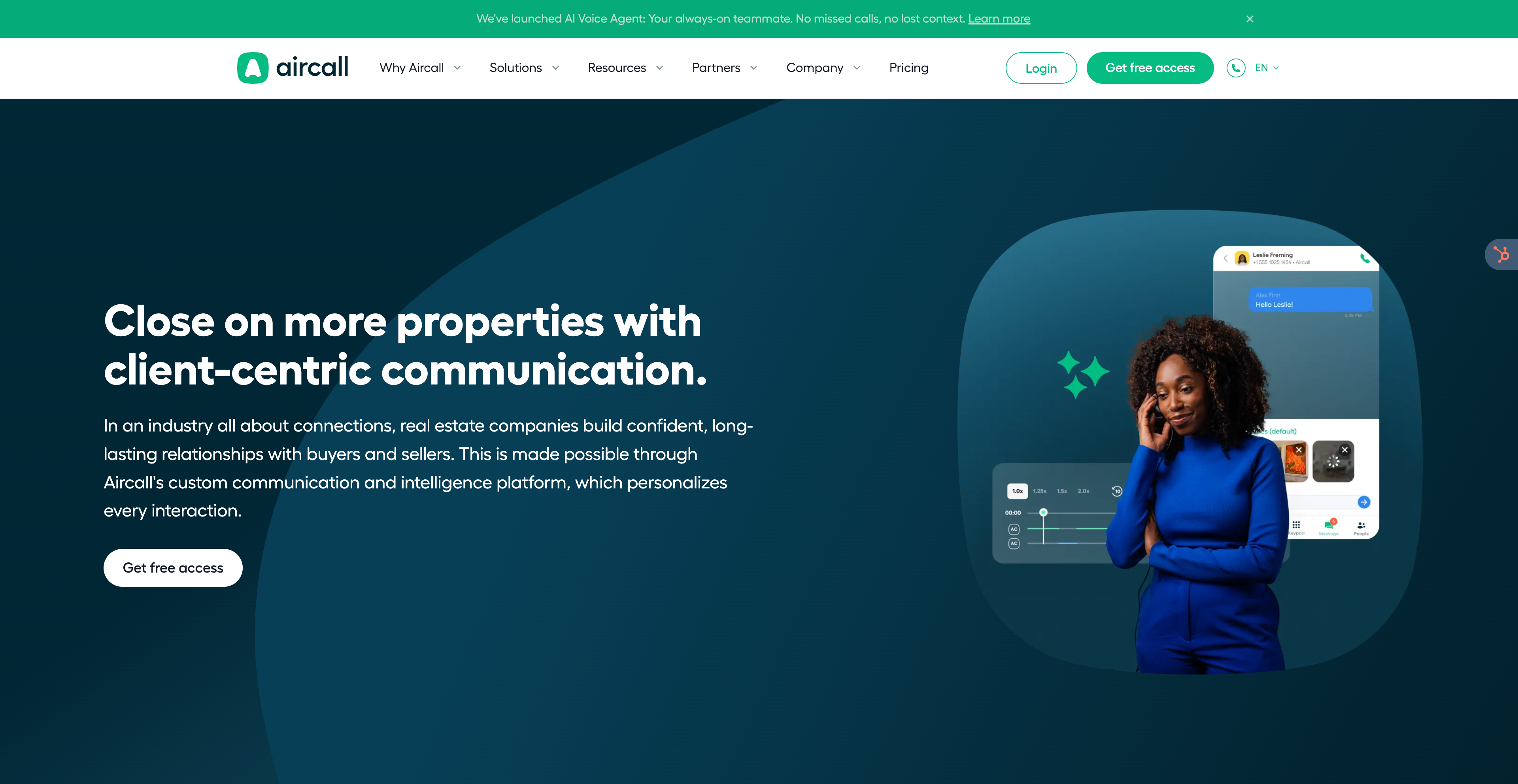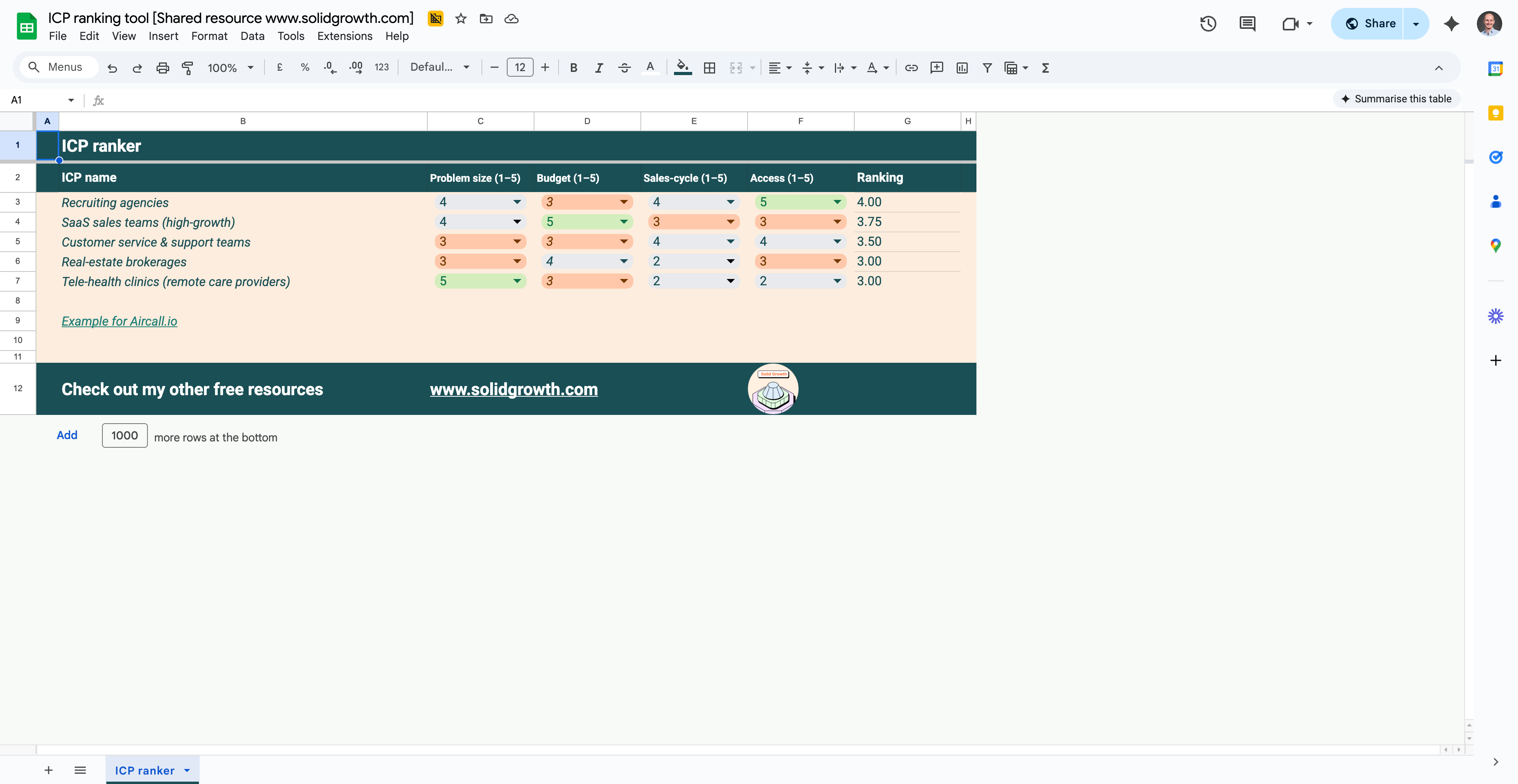Stop wasting budget on the wrong leads. This step-by-step guide shows you how to pin down your Ideal Customer Profile, tighten targeting and lift revenue with every campaign, backed by proven data.
%2520(1).webp)
Without clarity on your market, ideal-customer profile and personas, growth feels sluggish. Ads look generic, landing pages fail to click, and sales teams grind through calls that never convert. Tight focus flips that script: return on ad spend jumps, web forms light up and pipeline velocity soars.
In this chapter you will learn a practical three-layer model:
Theory is fine, but examples sink the lesson in. Let’s start with one of my favourites.
Aircall sells a cloud phone system to teams that live on calls. At first glance every company that dials a number could be a prospect. Look a little closer and the needs fragment fast.
Recruiters dial candidates and clients all day. They care about:

Estate agents juggle a torrent of inbound calls while racing between viewings. They need:

High-growth SaaS reps obsess over pipeline quality. They demand:

Same Aircall product, three ICPs, three targeted messages. Features matter, but only when they fix each group’s workflow. Now let us zoom out and choose your place in the market.
A sales team usually revolves around three roles. The SDR books meetings, the account executive runs demos, and the sales manager turns performance data into coaching. Each cares about Aircall [link] for a different reason.
Mark’s day is a blur of first-touch calls and hurried follow-ups. He wants a crystal-clear cue on when to reach back out, not a scribbled note he may misread later. With Aircall recording and transcribing every conversation, Mark skims the call moments that mention timing, and schedules his next touch point in Pipedrive in seconds. No more guessing; his follow-up lands precisely when prospects expect it.
Natalie’s calendar is wall-to-wall demos. This week she is pitching five law firms and needs slides that speak their language. With Aircall she can pull up the transcript of past phone calls and quickly find every objection from legal buyers and spot which value angle closed fastest. She rebuilds her deck around those insights, walks into the next demo with proof tailored to law firms and improves her close rate.
Anna leads two sales teams and wants to boost the pipeline win rate in both teams. She studies the best performers, so she can train the rest of the team in the best practices. She can mine all the call transcripts of the best performers with AI, so she can quickly find out what was working and train the rest of the sales team. The tactics of her stars become a coaching series for everyone, turning individual brilliance into team-wide consistency.
As this example illustrates, the personas inside an ICP, that sits inside a market can be different. You need to change communication based on the layer that you’re in. In the chapter on messaging, we’ll dive into how to actually do that, but first let me share the steps on how you can quickly decide on the 3 layers for your go-to-market strategy.
At the end of this chapter you will be able to choose the right market slice, list and rank your ICPs and lock in the personas who move deals, setting the stage for sharper pricing, messaging and channel choices that follow.
A market is simply a business problem serious enough for companies to spend money solving it. Voice-over-IP removes hardware headaches; customer-relationship management replaces sticky notes; GA4 tracking keeps the analytics lights on. A big trend, such as Apple curbing third-party cookies or AI writing call notes, can raise the temperature, yet the core remains the pain you ease.

Small companies decide in days and expect self-service.
Mid-size companies add a few approval layers and a longer contract.
Enterprises wheel in procurement, legal and security, stretching cycles yet offering larger contracts.
Low ticket (€) products rely on volume and near-zero acquisition cost.
Mid-price (€€) offers can fund a modest sales team or paid media programme.
High ticket (€€€) deals justify field reps, account-based marketing and heavy onboarding. Price and size are inseparable: a twenty-pound tool rarely funds a six-month enterprise sale.
.png)
If the square you want is empty, validate demand and stake your claim. Should a rival already occupy it, pick a separation line:
A clear box makes later choices straightforward. Next comes the question of which companies inside that box deserve your first burst of focus.
A single ideal-customer profile turns a broad box into a sharp target. Skip the exercise and campaigns drift; nail it and every touchpoint snaps into place.
Earlier we saw Aircall split the cloud-phone market three ways: recruiting agencies, real-estate brokerages and high-growth SaaS sales teams. Each group calls for different reasons, so each receives its own landing page, playbook and success story.
Markets behave the same in CRM land. The first wave offered one-size-fits-all databases. The second carved by funnel logic: HubSpot sits where marketing and sales meet, while Pipedrive doubles down on sales-only pipelines. The latest slices go razor thin, such as Folk, a LinkedIn-centred CRM for network-driven deal flow. The larger the market grows, the finer these cuts become.
Write down your own shortlist. If only one profile surfaces, move on. If you have several, the next step is to rank them.
Not every profile can come first. Rate each on the four yardsticks below, average the numbers and sort high to low.
How acute is the pain? A fund-raising scale-up drowning in manual lead entry hurts more than a hobbyist freelancer.
Can the firm pay your price? Series-B companies hold larger wallets than bootstrapped start-ups.
How quickly can they sign? A ten-person agency trials and decides in a fortnight; a two-hundred-seat enterprise may stretch to quarter-end.
How easily can you reach decision makers? Sales managers chat on LinkedIn; procurement teams hide behind shared inboxes.
To make life easier there is a lightweight Google Sheet with the rankings built in. Click File → Make a copy, drop in your own profiles and let the numbers point to the winner.
Make a copy in your own Google Sheets via this link

With the top profile selected we leave companies behind and turn to the humans who feel the pain and sign the order form.
The last layer to lock in is the people who make or break the deal. There are more people to influence than the people you market to directly. For example, a CFO or founder who needs to approve the budget will have an opinion too. You need to convince them indirectly as well. This is often called the decision-making unit (DMU). If there is a meeting where your potential client goes over the proposal with a few people without you there, that’s the decision-making unit.
Because the end-user and the person paying for your service or product have different goals, you need to speak to them in their own language. In this section, you’ll learn how to decide on the personas. It should be pretty straight forward to make this list for a single ICP you choose in the previous section.
Because the persona are the people inside the ICP, I’ve added this section in this chapter. We will use the personas in the chapter on messaging, for now we will make the persona list.
Start with recent opportunities. If you are already selling, comb through call recordings and closed-won notes. No sales history? Run quick customer-research interviews first – see the Customer Research playbook for a step-by-step. Typical roles for a sales-tool ICP look like:
Now create this list for the primary ICP on your list. Who are the decision makers? Write down the list. Three to five personas are enough for an early go-to-market push. More slows execution and muddies focus. List the primary and secondary influencers, then pick one or two champions to anchor your initial campaigns.
In this chapter you have:
With these three layers fixed you can move on to the next chapter and select the growth motion that best matches your price, market slice and target companies.
Use what you already have. But if you're starting from scratch or want recommendations, these are the tools I use with clients and personally rely on. Consider this a bonus: helpful if you need it, completely optional if you don't.
Topic
Playbook
Pick the right growth motion and you fund the channels that convert, hire the skills that matter and hit revenue targets sooner. Compare outbound, inbound, product and partner plays to choose with confidence.
Build a go to market plan that aligns your offer, motion and channel, so you stop guessing and start growing with purpose. Map goals, owners and next steps for the next quarter.
See playbook%2520(1).webp)
Use what you already have. But if you're starting from scratch or want recommendations, these are the tools I use with clients and personally rely on. Consider this a bonus: helpful if you need it, completely optional if you don't.
Tactical playbooks for every stage of this engine. The playbooks are practical guides for tactical stuff. They complement the (paid) growth framework and help you with the tactics.
Pick a prospecting method and tidy data. Warm domains, protect deliverability, build short email and LinkedIn sequences, and route positive replies to the right owner with tasks in the CRM.
See playbook
Post consistently on LinkedIn with a routine that grows authority, attracts buyers and turns visibility into pipeline. Turn posts into warm leads without spam or gimmicks.
See playbook
The books that shaped how I think about growth. Read summaries here, then buy what resonates. Learn from the best thinkers in B2B.

Dave Gerhardt
A guide to purposeful visibility. Choose topics, set a cadence and turn posts, talks and interviews into warm conversations.

Keith J. Cunningham
A practical summary of how businesses really grow. Clear levers, simple maths and actions you can take this quarter.
Key concepts and frameworks explained clearly. Quick reference when you need to understand a term, refresh your knowledge, or share with your team.
Topic
Playbook
Map the buyer journey from attention to action, crafting messages that guide prospects through each stage to conversion.
Topic
Playbook
Qualify leads systematically by assessing budget, authority, need, and timing to focus sales effort on high-potential opportunities.
Most B2B marketers are either Random Ricks (trying everything) or Specialist Steves (obsessed with one channel). Generalists run tactics without strategy. Specialists hit channel ceilings. But there's a better way.

Tries everything at once. Posts on LinkedIn, runs ads, tweaks the website, chases referrals. Nothing compounds because nothing's consistent. Growth feels chaotic.

Obsessed with one tactic. 'We just need better ads' or 'SEO will fix everything.' Ignores the rest of the system. One strong engine can't carry a broken machine.

Finds the bottleneck. Fixes that first. Then moves to the next weakest link. Builds a system that's predictable, measurable and doesn't need 80-hour weeks.
Learn how she diagnoses bottlenecks, orchestrates the four engines, and drives predictable growth. Choose if you want to read or watch:
Get practical frameworks delivered daily. Seven short emails explain how Sarah diagnoses bottlenecks, orchestrates the four engines, and builds systems that compound.
Free 45-minute video module from the full course. Watch how to diagnose your growth bottleneck and see exactly what the course platform looks like.
Stop wasting budget on the wrong leads. This step-by-step guide shows you how to pin down your Ideal Customer Profile, tighten targeting and lift revenue with every campaign, backed by proven data.
%2520(1).webp)